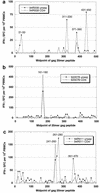Sustained peptide-specific gamma interferon T-cell response in rhesus macaques immunized with human immunodeficiency virus gag DNA vaccines
- PMID: 12208982
- PMCID: PMC136497
- DOI: 10.1128/jvi.76.19.10038-10043.2002
Sustained peptide-specific gamma interferon T-cell response in rhesus macaques immunized with human immunodeficiency virus gag DNA vaccines
Abstract
We examined the influence of dose and method of antigen delivery on the dynamics and durability of T-cell responses to candidate human immunodeficiency virus (HIV) vaccines. Codon-optimized sequences from the HIV gag gene were inserted into alternative DNA vaccine vectors to express the coding sequence with or without the tissue plasminogen activator leader sequence. We delivered the vaccines by intramuscular injection as plasmid DNA without adjuvant or as plasmid DNA formulated with a novel block copolymer adjuvant (CRL8623) and then monitored the ensuing T-cell responses by using a gamma interferon enzyme-linked immunospot assay. We demonstrated persistence of the cell-mediated immune (CMI) response in rhesus macaques for at least 18 months following a four-dose vaccination regimen. The plasmid vaccine, with or without CRL8623, was immunogenic in macaques; however, the form coadministered with adjuvant exhibited improved T-cell responses, with a bias toward more antigen-specific CD8(+) T cells. Finally, we examined the fine specificity of the T-cell response to the gag vaccines by testing the response of 23 vaccinated macaques to individual Gag 20-mer peptides. Collectively, the monkeys responded to 25 epitopes, and, on average, each monkey recognized a minimum of 2.7 epitopes. The results indicate that a broad and durable CMI response to HIV DNA vaccines can be induced in a relevant nonhuman primate model.
Figures



Similar articles
-
Expression and immunogenicity of sequence-modified human immunodeficiency virus type 1 subtype B pol and gagpol DNA vaccines.J Virol. 2003 Jun;77(11):6197-207. doi: 10.1128/jvi.77.11.6197-6207.2003. J Virol. 2003. PMID: 12743276 Free PMC article.
-
DNA Prime-Boost Vaccine Regimen To Increase Breadth, Magnitude, and Cytotoxicity of the Cellular Immune Responses to Subdominant Gag Epitopes of Simian Immunodeficiency Virus and HIV.J Immunol. 2016 Nov 15;197(10):3999-4013. doi: 10.4049/jimmunol.1600697. Epub 2016 Oct 12. J Immunol. 2016. PMID: 27733554 Free PMC article.
-
Potent specific immune responses induced by prime-boost-boost strategies based on DNA, adenovirus, and Sendai virus vectors expressing gag gene of Chinese HIV-1 subtype B.Vaccine. 2008 Nov 11;26(48):6124-31. doi: 10.1016/j.vaccine.2008.09.017. Epub 2008 Sep 22. Vaccine. 2008. PMID: 18812199
-
The potential of topical DNA vaccines adjuvanted by cytokines.Expert Opin Biol Ther. 2007 Oct;7(10):1563-74. doi: 10.1517/14712598.7.10.1563. Expert Opin Biol Ther. 2007. PMID: 17916048 Review.
-
Multivalent vaccines: prospects and challenges.Folia Microbiol (Praha). 1997;42(2):105-12. doi: 10.1007/BF02898716. Folia Microbiol (Praha). 1997. PMID: 9306653 Review.
Cited by
-
Validation of an IFN-gamma ELISpot assay to measure cellular immune responses against viral antigens in non-human primates.Gene Ther. 2022 Feb;29(1-2):41-54. doi: 10.1038/s41434-020-00214-w. Epub 2021 Jan 11. Gene Ther. 2022. PMID: 33432123 Free PMC article.
-
DNA vaccines against human immunodeficiency virus type 1 in the past decade.Clin Microbiol Rev. 2004 Apr;17(2):370-89. doi: 10.1128/CMR.17.2.370-389.2004. Clin Microbiol Rev. 2004. PMID: 15084506 Free PMC article. Review.
-
Protection against Mucosal SHIV Challenge by Peptide and Helper-Dependent Adenovirus Vaccines.Viruses. 2009 Dec 1;1(3):920. doi: 10.3390/v1030920. Viruses. 2009. PMID: 20107521 Free PMC article.
-
Vesicular stomatitis virus-based vaccines protect nonhuman primates against aerosol challenge with Ebola and Marburg viruses.Vaccine. 2008 Dec 9;26(52):6894-900. doi: 10.1016/j.vaccine.2008.09.082. Epub 2008 Oct 18. Vaccine. 2008. PMID: 18930776 Free PMC article.
-
Functional profiling of Covid 19 vaccine candidate by flow virometry.Vaccine. 2022 Sep 2;40(37):5529-5536. doi: 10.1016/j.vaccine.2022.08.006. Epub 2022 Aug 9. Vaccine. 2022. PMID: 35985887 Free PMC article.
References
-
- Akridge, R., F. Hladik, J. Markee, C. Alef, H. Kelley, A. Collier, and M. J. McElrath. 1999. Cellular immunity and target cell susceptibility in persons with repeated HIV-1 exposure. Immunol. Lett. 66:15-19. - PubMed
-
- Allen, T. M., B. R. Mothé, J. Sidney, P. Jing, J. L. Dzuris, M. E. Liebl, T. U. Vogel, D. H. O'Connor, X. Wang, M. C. Wussow, J. A. Thomson, J. D. Altman, D. I. Watkins, and A. Sette. 2001. CD8+ lymphocytes from simian immunodeficiency virus-infected rhesus macaques recognize 14 different epitopes bound by the major histocompatibility complex class I molecule Mamu-A∗01: implications for vaccine design and testing. J. Virol. 75:738-749. - PMC - PubMed
-
- Barouch, D. H., J. Kunstman, M. J. Kuroda, J. E. Schmitz, S. Santra, F. W. Peyerl, G. R. Krivulka, K. Beaudry, M. A. Lifton, D. A. Gorgone, D. C. Montefiori, M. G. Lewis, S. M. Wolinsky, and N. L. Letvin. 2002. Eventual AIDS vaccine failure in a rhesus monkey by viral escape from cytotoxic T lymphocytes. Nature 415:335-339. - PubMed
-
- Boyer, J. D., K. E. Ugen, B. Wang, M. Agadjanyan, L. Gilbert, M. L. Bagarazzi, M. Chattergoon, P. Frost, A. Javadian, W. V. Williams, Y. Refaili, R. Ciccarelli, D. McCallus, L. Coney, and D. B. Weiner. 1997. Protection of chimpanzees from high-dose heterologous HIV-1 challenge by DNA vaccination. Nat. Med. 3:526-532. - PubMed
-
- Cohen, J. 1999. AIDS vaccines. Glimmerings of hope from the bottom of the well. Science 285:656-657. - PubMed
MeSH terms
Substances
LinkOut - more resources
Full Text Sources
Other Literature Sources
Research Materials
Miscellaneous

